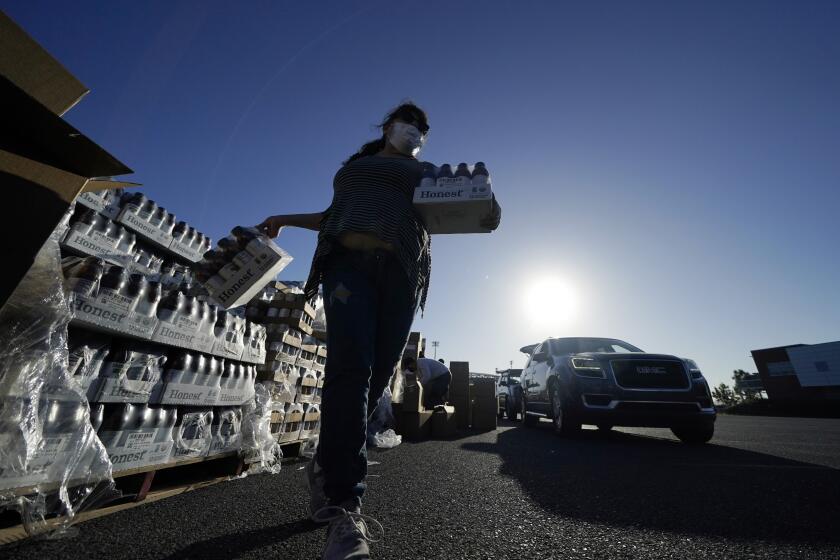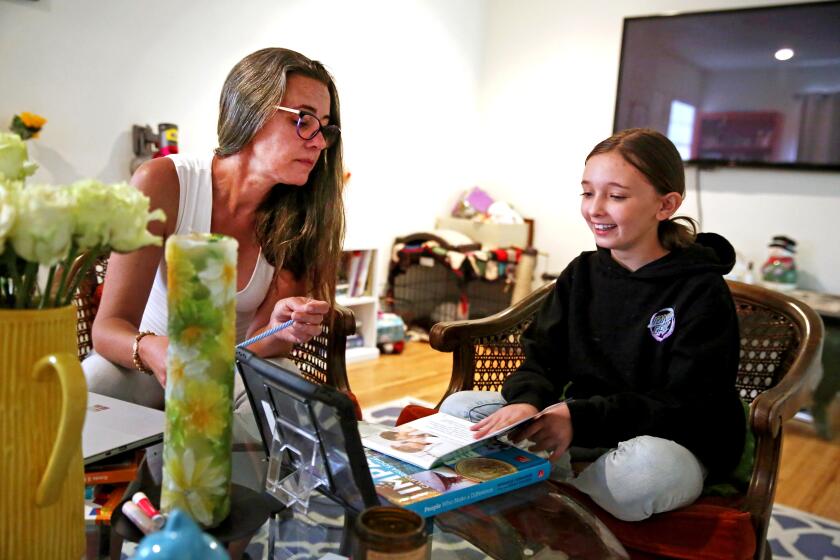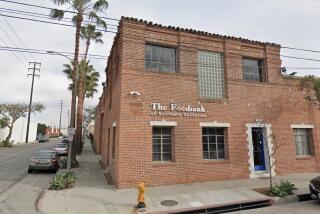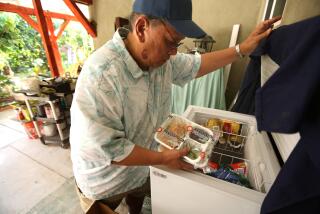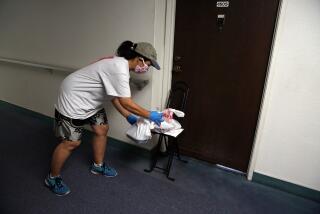Fewer in U.S. turn to food banks, but millions are still in need

- Share via
WASHINGTON — Hunger and food insecurity across the United States have dropped measurably over the last six months, but the need remains far above pre-pandemic levels. And specialists in hunger issues warn that the situation for millions of families remains extremely fragile.
An Associated Press review of bulk distribution numbers from hundreds of food banks across the country revealed a clear downward trend in the amount of food handed out across the country, starting in the spring as the COVID-19 vaccine rollout took hold and closed sectors of the economy began to reopen.
“It’s come down, but it’s still elevated,” said Katie Fitzgerald, chief operating officer of Feeding America, a nonprofit organization that coordinates the efforts of more than 200 food banks across the country and that provided the AP with the national distribution numbers. She warned that despite the recent decreases, the amount of food being distributed by Feeding America’s partner food banks remained more than 55% above pre-pandemic levels. “We’re worried [food insecurity] could increase all over again if too many shoes drop,” she said.
Those potential setbacks include the advance of the Delta variant of the coronavirus, which has already delayed planned returns to the office for millions of employees and which could threaten school closures and other shutdowns as the nation enters the winter flu season. Other obstacles include the gradual expiration of several COVID-19-specific protections such as the eviction moratorium and expanded unemployment benefits.
All told, families facing food insecurity find themselves still dependent on outside assistance and extremely vulnerable to unforeseen difficulties.
“There are people going back to work, but it’s slow going and God forbid you should need a car repair or something,” said Carmen Cumberland, president of Community Harvest Food Bank in Fort Wayne, Ind.
Nationally, the food banks that work with Feeding America saw a 31% increase in the amount of food distributed in the first quarter of 2021 compared with the first quarter of 2020, just before the pandemic reached America.
When the nationwide closures of offices and schools began in March 2020, the effect was immediate. Feeding America-affiliated food banks distributed 1.1 billion pounds of food in the first quarter of 2020; in the second quarter, the number jumped 42% to more than 1.6 billion pounds. The third quarter saw a smaller, 5% increase up to nearly 1.7 billion pounds of food. Although distributions declined from the end of 2020 to the first quarter of 2021, recent data suggest that the decline has leveled off.
As a year marked by the coronavirus nears an end, millions of Americans are depending on food banks to stave off hunger.
The national data are mirrored in the experiences of individual food banks across the country. At the Alameda County Community Food Bank in Oakland, the level of community need rose in winter and early spring of this year. In February 2021, the organization set a record with 5 million pounds of food distributed. That record stood for one month as March saw 6 million pounds distributed.
After the March peak, the numbers started dropping steadily — down to 4.6 million pounds in August 2021. But that’s still high compared with 2.7 million pounds in June 2019.
“The recovery is going to be very, very long and steep for families who are typically reliant on food banks,” said Michael Altfest, the food bank’s director of community engagement. Altfest said the pandemic was an additional trauma for families already suffering from food insecurity, and it introduced a whole new category of client who had never used food banks before but had been pushed over the financial edge by the pandemic. Both categories are projected to remain in need of assistance well into next year.
“Things are not getting any easier here for low- and moderate-income households, and we don’t expect it to for a while,” Altfest said.
Among those newcomers to the food bank system is Ranada James. The 47-year-old child care professional had received Supplemental Nutrition Assistance Program, or SNAP, benefits in the past but never dealt with a food bank before the pandemic. On a recent overcast Wednesday, James was one of a few dozen people lining up in their cars for a weekly drive-through food pantry operated by a local charity called the Arc in southeast Washington, the poorest and most virus-ravaged part of the district. Volunteers loaded her backseat with pre-prepared hot meals, lunch sacks, fresh vegetables from the Arc’s garden and sealed boxes of durable goods.
“I never thought I would need it,” she said. “It helped tremendously, and it still really helps.”
Even as the situation slowly improves, James finds herself in need. She has two grandchildren and two nieces living with her, and she’s keeping them from attending in-person school out of fear of the pandemic — which means she can’t go back to work.
“They really do eat,” she said with a laugh, adding that broccoli and fresh string beans were household favorites. “They’re growing, and they’re picky.”
Other food banks across the country are reporting similar trends: a gradual decrease this year, starting around April, but still far higher than any pre-pandemic numbers. At the Central California Food Bank in Fresno, the numbers have “leveled off” in recent months but remain 25% higher than in 2019, said the food bank’s co-chief executive, Kym Dildine.
“Many people are still out of work, particularly women, who are the primary caregivers in the home,” she said.
School may be in session, but the dearth of child care is still proving to be a major hurdle to women reentering the U.S. labor market.
At the Capital Area Food Bank in Washington, the amount of food distributed in July was 64% higher than in the same month in 2019.
“COVID isn’t over by any means,” said the food bank’s president, Radha Muthiah. “We’re still seeing existing need.”
Just how long the elevated level of need will last is a matter of debate, with the most conservative estimates projecting it will persist well into the summer of 2022. Some are predicting that the country’s food banks may never return to normal.
Parallel government food assistance programs such as SNAP benefits, commonly known as food stamps, also saw a pandemic-fueled increase in usage. The Department of Agriculture, which administers SNAP, reports that the number of SNAP users increased by 7 million between 2019 and 2021. In August, President Biden instituted a permanent 25% boost in SNAP benefits, starting this month.
But the SNAP program doesn’t come close to covering every family in need. Muthiah said many of the clients who depend on food banks for their nutrition are either ineligible for SNAP benefits, intimidated by the bureaucratic paperwork or fearful of applying due to their immigration status. That leaves food banks as the primary source of aid for millions of hungry people.
Secretary of Agriculture Tom Vilsack told the AP that at the peak of the pandemic, 14% of American adults were receiving SNAP benefits. That number is now down around 8%, but the need remains highly elevated, and nonprofit charitable options such as food banks serve a vital role in papering over the remaining holes in millions of family budgets, he said.
“We just need to understand what this pandemic has done in terms of significant disruption of what was probably a pretty fragile system to begin with,” said Vilsack, who also filled the same Cabinet post in the Obama administration. ”It has exposed the fragility of the system, which makes programs like SNAP, programs like summer feeding programs, school feeding programs, food bank assistance ever more important.”
Vilsack said the Biden administration has moved to strengthen the national food bank infrastructure by devoting $1 billion in June to help fund refrigerated trucks and warehouses that will allow food banks to store and provide more fresh fruits, vegetables and dairy products.
Now the country’s food bank network is busy trying to project the level of need going forward, factoring in multiple influences — positive and negative. Theoretically, the boosted Child Tax Credit payments, which started in July, are meant to alleviate the monthly burden for lower-income and middle-class families by providing money to use as the families see fit. But food bank executives and researchers estimate that it could take six to 12 months to see a real effect on food security as families initially devote those funds to issues such as rent or car repairs.
And the end of the nationwide eviction moratorium looms as a major pressure point that could push vulnerable families back into crisis.
The Biden administration allowed the federal moratorium to expire in late August, and Congress did not extend it. While the federal government now focuses on pumping money into rental assistance programs, the national moratorium has devolved into a patchwork of localized moratoriums, in places such as Washington, Boston and New York state — all expiring on different schedules.
At the southeast Washington drive-through food pantry, volunteers there have developed friendships with some of the regulars, including Rob and Devereaux Simms. A retired bus driver and a school aide in their 70s, they consider themselves solidly middle class and had never used food stamps. But when the pandemic hit and two of their children were laid off, “things started running short,” Devereaux Simms said.
Now, with three grandchildren living at home, they’re fixtures at the Wednesday drive-through. They even make a point of taking home extra supply boxes to distribute to needy neighbors and recently took small gifts for the volunteers.
“God’s been good to us,” Devereaux Simms said, “and you should never be too proud to accept help.”
Associated Press writer Michael Casey in Boston and data journalist Camille Fassett in Oakland contributed to this report.
More to Read
Sign up for Essential California
The most important California stories and recommendations in your inbox every morning.
You may occasionally receive promotional content from the Los Angeles Times.
